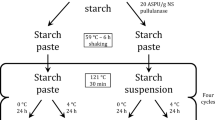Abstract
The cultivation of the hyperthermophilic archaeobacterium Pyrococcus woesei on starch under continuous gassing (80% H2:20% CO2) caused the formation of 250 U/l of an extremely thermoactive and thermostable α-amylase. In a complex medium without elemental sulphur under 80% N2 and 20% CO2 atmosphere enzyme production could be elevated up to 1000 U/l. Pyrococcus woesei grew preferentially on poly-and oligosaccharides. The amylolytic enzyme formation was constitutive. Enzyme production was also observed in continuous culture at dilution rates from 0.1 to 0.4 h-1. A 20-fold enrichment of α-amylase was achieved after adsorption of the enzyme onto starch and its desorption by preparative gel electrophoresis. The α-amylase consisted of a single subunit with a molecular mass of 70 000 and was catalytically active at a temperature range between 40°C and 130°C. Enzymatic activity was detected even after autoclaving at a pressure of 2 bars at 120°C for 5 h. The purified enzyme hydrolyzed exclusively α-1,4-glycosidic linkages present in glucose polymers of various sizes. Unlike many α-amylases from anaerobes the enzyme from P. woesei was unable to attack short chain oligosaccharides with a chain length between 2 and 6 glucose units.
Similar content being viewed by others
References
Antranikian G (1990) Physiology and enzymology of anaerobic bacteria degrading starch. FEMS Microbiol Rev 75:201–218
Antranikian G, Koch R, Spreinat A (1989) German Patent No. 3909096.5
Belay N, Sparling R, Daniels L (1984) Dinitrogen fixation by a thermophilic methanogenic bacterium. Nature 312:286–288
Bergmeyer HU, Grassl M (1983) Reagents for enzymatic analysis enzymes-α-amylase. In: Bergmeyer HU (ed) Methods of enzymatic analysis, 3rd edn, vol 2. Verlag Chemie, Weinheim, pp 151–152
Blumentals I, Robinson A, Kelly R (1990) Characterization of sodium dodecyl sulfate-resistent proteolytic activity in the hyperthermophilic archaebacterium Pyrococcus furiosus. Appl Environ Microbiol 56:1992–1998
Brown S, Costantino H, Kelly R (1990) Characterization of amylolytic enzyme activities associated with the hyperthermophilic archaebacterium Pyrococcus furiosus. Appl Environ Microbiol 56:1985–1991
Bryant FO, Adams M (1989) Characterization of hydrogenase from the hyperthermophilic archaebacterium, Pyrococcus furiosus. J Biol Chem 264:5070–5079
Constantino H, Brown S, Kelly R (1990) Purification and characterization of α-glucosidase from a hyperthermophilic archaebacterium, Pyrococcus furiosus, exhibiting a temperature optimum of 105 to 115°C. J Bacteriol 172:3654–3660
Fiala G, Stetter KO (1986) Pyrococcus furiosus sp. nov. represents a novel genus of marine heterotrophic archaebacteria growing optimally at 100°C. Arch Microbiol 145:56–61
Heukeshoven J, Dernick R (1985) Simplified method for silver staining of proteins in polyacrylamide gels and the mechanism of silver staining. Electrophoresis 6:103–112
Huber R, Kristjansson JK, Stetter KO (1987) Pyrobaculum gen. nov., a new genus of neutrophilic, rod-shaped archaebacteria from continental solfataras growing optimally at 100°C. Arch Microbiol 149:95–101
Huber R, Kurr M, Jannasch W, Stetter KO (1989) A novel group of abyssal methanogenic archaebacteria (Methanopyrus) growing at 110°C. Nature 342:833–834
Ihara H, Sasaki T, Tsuboi A, Yamagata H, Tsukagoshi N, Udaka S (1985) Complete nucleotide sequence of a thermostable α-amylase gene: homology between prokaryotic and eukaryotic α-amylase at the active site. J Biochem 98:95–103
Klingeberg M, Hashwa F, Antranikian G (1990) Properties of extremely thermostable proteases from anaerobic hyperthermophilic bacteria. App Microbiol Biotechnol 34:715–719
Koch R, Spreinat A, Antranikian G (1989) Characterization of amylase from Pyrococcus woesei. Abstract at the VAAM-Meeting, vol 1–2:86
Koch R, Zablowski P, Spreinat A, Antranikian G (1990) Extremely thermostable amylolytic enzymes from the archeabacterium Pyrococcus furiosus. FEMS Lett 71:21–26
Melasniemi H (1988) Purification and some properties of the extracellular α-amylase-pullulanase produced by Clostridium thermohydrosulfuricum. Biochem J 250:813–818
Stetter KO (1986) Diversity of extremely thermophilic archaebacteria. In: Brock TD (ed) Thermophiles. John Wiley & Sons, New York, pp 39–74
Stetter KO, König H, Stackebrandt E (1983) Pyrodictium gen. nov., a new genus of submarine disc-shaped sulphur reducing archaebacteria growing optimally at 105°C. Syst Appl Microbiol 4:535–551
Wiegel J, Ljungdahl LG (1986) The importance of thermophilic bacteria in biotechnology. CRC Crit Rev Biotechnol 3:39–107
Yang M, Galizzi A, Henner D (1983) Nucleotide sequence of the amylase gene from Bacillus subtilis. Nucleic Acids Res 11:237–249
Yuuki T, Nomura T, Tezuka H, Tsuboi A, Yamagata H, Tsukagoshi N, Udaka S (1985) Complete nucleotide sequence of a gene coding for heat and pH stable α-amylase of Bacillus licheniformis: comparison of the amino acid sequences of three bacterial liquefying α-amylases deduced from the DNA sequence. J Biochem 98:1147–1156
Zillig W, Holz I, Klenk HP, Trent J, Wunderl S, Janekovic D, Imsel E, Haas B (1987) Pyrococcus woesei sp. nov., an ultrathermophilic marine archaebacterium, representing a novel order, Thermococcales. Syst Appl Microbiol 9:62–70
Zwickl P, Fabry S, Bogedain C, Haas A, Hensel R (1990) Glyceraldehyde-3-phosphate dehydrogenase from the hyperthermophilic archaebacterium Pyrococcus woesei: characterization of the enzyme, cloning and sequencing of the genes, and expression in Escherichia coli. J Bacteriol 172:4329–4338
Author information
Authors and Affiliations
Rights and permissions
About this article
Cite this article
Koch, R., Spreinat, A., Lemke, K. et al. Purification and properties of a hyperthermoactive α-amylase from the archaeobacterium Pyrococcus woesei . Arch. Microbiol. 155, 572–578 (1991). https://doi.org/10.1007/BF00245352
Received:
Accepted:
Issue Date:
DOI: https://doi.org/10.1007/BF00245352




